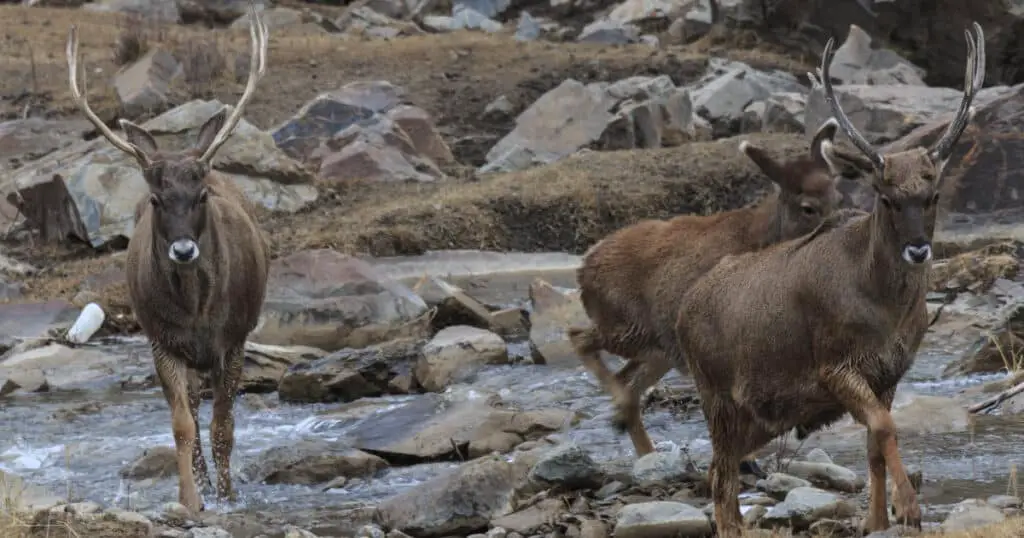White Lipped Deer (Cervus albirostris), also known as Thorold’s Deer, is a large and impressive species native to the Tibetan Plateau. The latin name, albirostris, comes from the latin albus (white) and rostrum (snout), and describes the distinctive white lips and muzzle of this deer, one which plays a vital ecological role in the alpine region of Tibet.
On this page we’ll discuss the history of Thorold’s Deer, their size, physical appearance, behavior, range, and preferred habitat.
What Size are White Lipped Deer?
- Head & Body Length – 190 to 200 cm
- Shoulder Height – 120 to 130 cm
- Tail Length – 10 to 12 cm
- Weight – 130 to 140 kg
What do White Lipped Deer Look Like?
The muzzle of the Thorold’s Deer is all white in color, and the eyes have distinct white-eye rings. Further patches of white fur are found on the throat and chin.
A large animal, the White Lipped Deer is one of the largest of all the deer species. The legs are long and slender, and the head short.
The ears are long and narrow, and in females have a short tuft of white hair.
The hooves are large and broad, enabling them to climb easily through rough terrain. The dewclaws are well developed.
Coloration
Thorold’s deer have a dark brown colored upper coat. The under parts and the inside of the legs is a paler white color. During the winter months the coat is paler in color, and is roughly twice as long as the summer coat.
The hair on this deer’s back grows in the opposite direction to the rest of its coat, which gives the back a raised and ruffled appearance.
Antlers
Only males carry antlers. Mature males typically have antlers with a total of 6 tines, although some animals may have antlers with as many as 10 tines.
The antlers of Thorold’s Deer grow forwards, but are carried fairly low and flattened on the male’s head. They can grow to a maximum length of 130 cm, and each antler can weigh as much as 7 kg.
The antlers of Thorold’s deer are unusual in that they have a creamy white color, unlike the more typical brown or black seen in the antlers of most other deer.
Distribution & Habitat of Thorold’s Deer
The White Lipped Deer is found across Tibet and parts of adjoining China.
Populations have fallen heavily mainly because of over hunting. Many of the deer’s body parts are used in oriental medicine and the deer is killed by Chinese hunters who can earn a lot of money from the deer.
Another problem the deer faces is habitat loss. The IUCN classifies White Lipped Deer as vulnerable. There are about 100,000 remaining animals in the wild.
Preferred Habitat
These deer live on the high mountain slopes of the Himalayas and surrounding areas. They prefer habitats that have a mixture of forest and open clearings.
Thorold’s Deer are often found in areas of Rhododendron forest. They occur at altitudes above 3,500 metres.
Although they are found over a fairly large range area, their distribution is patchy because suitable habitat for these deer is also distributed unevenly.
How Long do White Lipped Deer Live?
Thorold’s Deer have a maximum lifespan of 18 to 19 years of age, although few reach this age in the wild.
What Do Cervus Albirostris Eat?
They feed mainly on grasses and herbaceous plants found in the mountain habitats in which they live.
Mating Habits & Reproductive Cycle
The mating or rutting season takes place in the autumn between October and December.
At this time of year the male and female herds that have lived separately for much of the previous year join together. Reported herd numbers at this time of year are reported as being between 50 and 300 animals.
Competition During the Rut
Males compete with each other for access to females, using their antlers in contests to decide which male is strongest and should get to breed with a receptive female.
During the rut the males expend a lot of energy and quickly lose condition.
Male White Lipped Deer have a distinctive rutting roar.
Raising Young
A single fawn is born in the following spring in May or June after the deer’s gestation period of between 260 and 280 days. Sometimes twins are born, but this is uncommon — typically Thorold’s Deer have only one fawn.
The young are mobile soon after birth. The deer’s fawns are able to walk and run only half an hour after being born. While some deer hide their young, White Lipped fawns begin to accompany their mother’s herd right away.
The young are suckled for 10 months before they become fully independent. When they reach independence, males join the male bachelor herds while the females remain in the mother’s herd with other female deer.
Sexual maturity occurs quite late in this species, at 3 years in the females. Males are not strong enough to breed until they are 4 years or more in age.
Unique Behavior & Habits
This is a social animal, living in small herds of up to 30 animals.
The sexes are segregated with males living separately from females and younger animals.
Older males are more solitary in behavior. Thorold’s deer are mobile in habit, continually moving around in search for food in the bleak habitat in which they live.
White Lipped Deer are good climbers, happy in rough and mountainous areas.
They are wary of man and as a result, they are difficult to observe in the wild.
These deer are mostly active during the day, feeding in the early mornings and late afternoons.
In China this species is being increasingly farmed and kept in captivity since many parts of this deer are believed to have medicinal properties in that culture.


